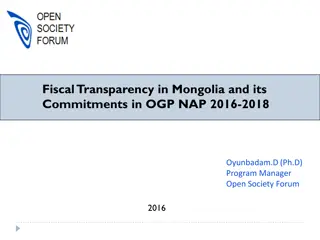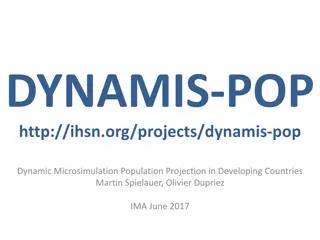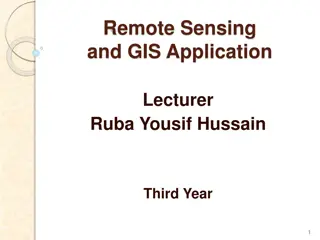Subnational Population Projections Workshop Highlights
The International Workshop on Subnational Population Projections discussed methods for preparing subnational projections using a bottom-up approach and integrating them into national projections. The session also covered the use of Spectrum software to generate subnational projections and steps involved in the process. The workshop emphasized the importance of consistency in projections at both subnational and national levels.
Download Presentation

Please find below an Image/Link to download the presentation.
The content on the website is provided AS IS for your information and personal use only. It may not be sold, licensed, or shared on other websites without obtaining consent from the author.If you encounter any issues during the download, it is possible that the publisher has removed the file from their server.
You are allowed to download the files provided on this website for personal or commercial use, subject to the condition that they are used lawfully. All files are the property of their respective owners.
The content on the website is provided AS IS for your information and personal use only. It may not be sold, licensed, or shared on other websites without obtaining consent from the author.
E N D
Presentation Transcript
International Workshop on Subnational Population Projections using Census Data 17 18 January 2013 Beijing, China
Session 4: Preparing subnational projections using a bottom-up approach National projections with subnational components: an integrated approach Stand-alone subnational projections using the cohort-component method
National projections with subnational components: an integrated approach Overview
National projections with subnational components A national projection with subnational components is usually performed by a central authority of the country, often in collaboration with regional or subnational institutions. One approach could be the simultaneous preparation of all subnational projections using the standard cohort-component method and software. In a second step, the national projection is then obtained by aggregating all subnational projections. For the latter, the projection software needs to have special functionality.
Using Spectrum to generate subnational projections I Spectrum offers a special functionality to aggregate several projections into one for a larger area (country) Spectrum does not (yet) provide consistency mechanisms that guarantee that individual projections are consistent with and add up to the national total.
Using Spectrum to generate subnational projections II Steps involved are: Prepare independently projections for each subnational entity (region, province) and save it. Include AIDS required. In order to aggregate the individual subnational projections, create a list of member regions and save it. Process the list. Obtain the summary indicators.
Using Spectrum to generate subnational projections III
Using Spectrum to generate subnational projections IV
Using Spectrum to generate subnational projections V
Using Spectrum to generate subnational projections VI
Using Spectrum to generate subnational projections VII
Using Spectrum to generate subnational projections VIII
Using Spectrum to generate subnational projections IX
Using Spectrum to generate subnational projections X
Using Spectrum to generate subnational projections XI Spectrum can be used for explorative subnational projections that can be compared and aggregated. Spectrum lacks some features that are required for a fully specified and consistent subnational projection program, such as an ability to enforce consistency with a given national projection and complete output by age )some indicators. The necessity to specify HIV/AIDS adds complexity.
National projections with subnational components: Multistate approach Another, more comprehensive and elegant, approach is to employ a multi-state or multi- regional projection framework. Here the subnational populations and their demographic characteristics enter the model together.
National projections with subnational components: Multistate approach The model has special and demanding requirements regarding (internal) migration. For each subnational area, migration needs to be fully specified in terms of immigration by sending subnational area and for emigration by destination area. Altogether, this forms a gross migration matrix with as many rows and columns as there are subnational regions. If international migration needs to be included, an additional virtual region could be added representing the outside world.
Stand-alone subnational projections using the cohort-component method Overview
Stand-alone subnational projections There is a need for standalone population projections that benefit for the advantages of the cohort-component methodology but avoid the heavy administrative and organizational overhead of coordinated national population projections with subnational components. Such need arises from emerging and ad-hoc policy and planning requirements that need population projection data as its basis.
Stand-alone subnational projections Standalone population projections can be prepared like a national population projection, using the same software. Migration needs to be dealt with in a more comprehensive way, by combining internal migration and international migration.
Stand-alone subnational projections: Migration It is useful to prepare internal and international migration separately, but to combine both into net migration. As for national projections, it is advisable to formulate migration assumption in term of absolute numbers.
Other software RUPEX US Census Bureau Rural-Urban Projection Program with EXCEL interface United Nations MORTPAK projection program PROJCT LIPRO multi-state projection program (LIfestyle PROjections)
USCB RUPEX Description The program uses the cohort component method for projecting the population by age and sex. The projection is made following cohorts by single years of age, even if all or some of the input data are in five year age groups. Using interpolated values of central death rates from life tables, RUP estimates the number of deaths and subtracts them from each cohort. It also takes into account internal and international migration. Every year births are estimated using fertility rates and the female population in reproductive ages. The annual number of births constitute new population cohorts that are followed through in the future.
USCB RUPEX Advantages: Reliable and well tested methodology Large user base Professional support On-site Training available Integration with analysis tools Disadvantages User interface somewhat non-intuitive (Excel based) Data format of input file text based and not self explanatory Still in testing for Windows Vista/Win7
United Nations MORTPAK Population Projection
LIPRO Multistate projection program developed by NIDI, Netherlands Although originally developed for household projections, the LIPRO computer program can be used for a wide range of calculations in multistate demography. LIPRO has been extensively used for various applications, in the Netherlands as well as in many other countries.
LIPRO Consistency algorithms exist and can be expanded. Powerful, but demanding. No further development Runs only under Windows XP
LIPRO Projection data must be prepared outside: age-specific rates of change for each region/unit. Their evolution over time can be controlled through a scenario module. Alternatively, the number of events by age and sex can be inputted; LIPRO will then calculate the rates/probabilities. Challenge: Age-specific migration rate matrix: Origin and destination, by age.
LIPRO Belgium - LIPRO household typology China - population projections Shanghai Marital status projections for England & Wales. Spain - population projections Catalonia Paper on: Internal migration scenarios and regional population projections for the European Union. International Journal of Population Geography http://www.nidi.knaw.nl/Pages/NID/24/841.bGFuZz1VSw.html
PPPM Probabilistic Population Projection Model Developed at University Rostock, Germany Features Separate assumptions in mortality, fertility, and migration for subpopulations, i. e. for natives, immigrants, emigrants, and their descendant generations Generates multiple assumptions in mortality, fertility, and migration for each subpopulation with any method Powerful output analysis and reporting Free to use and adapt (Apache 2.0 License)
PPPM Still under development (beta) Complex software, demanding data requirements
PADIS-INT New features and advantages 1. Web-accessibility 2. Less environmental dependence: PADIS-INT does not rely on any operating system (Windows, Unix, and Linux) and can be accessed by any browser 3. Use of the latest technology, which enrich users interactive experience and improve the robustness, efficiency, safety, and reliability of the system and its distributed deployment. 4. Simple data input and flexibility: Users only need to provide very basic data such as the age-sex distribution of the population in the starting year and other demographic variables in the future such as total fertility rate, age-pattern of fertility, life expectancy at birth by sex, net migration rate by sex, and age pattern of migration by sex. 5. Rich in graphics and outputs






















